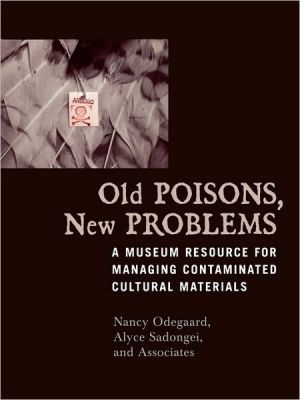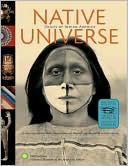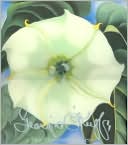Old Poisons, New Problems
Old Poisons, New Problems is a timely and welcome practical guide to identifying, testing for, and dealing with contaminated cultural materials archived in museum collections. With increasing indigenous involvement in the collection, handling, and—more recently—the repatriation of cultural artifacts formerly held in museum archives, there is an increasing need to educate both the museum community and tribal members about the potential risks of pesticide contamination on museum collections,...
Search in google:
Old Poisons, New Problems is a practical guide to identifying, testing for, and dealing with contaminated cultural materials archived in museum collections. Special features include worksheets for performing basic tests, charts of scientific and historical information on known pesticides, data resources, and illustrations. This book will be useful to the museum community and tribal groups involved with the management and/or repatriation of these collections.
ForewordNAGPRA legislation overview1Describing the problem : contaminated artifacts and Hopi cultural use12Identifying the pesticides : pesticide names, classification, and history of use53Addressing the problem : the team approach334Assessing contamination : analytical testing of cultural materials for pesticides535Understanding the hazards : toxicity and safety736Conclusion85App. AGuidelines for handling contaminated museum collections87App. BPersonal protection equipment guidelines89App. CSafety equipment and chemical supplies directory91App. DGuide to reading material safety data sheets93App. EHealth and safety information resources95App. FAgencies for contacting professionals and consultants97App. GPesticide information Websites101
\ Marian A. KaminitzOld Poisons, New Problems, combines Native Peoples' perspectives on their pesticide contaminated collections with handbook style chapters covering everything from the 'how-to' of testing for pesticides, to specific information on pesticides likely to be found on museum collections, to working with teams of allied professionals in addressing the repatriation of contaminated cultural materials. This book is a must for anyone who deals with cultural materials that might have been treated with pesticides.\ \ \ \ \ David Lee SmithThis book is well written and very informative. As NAGPRA Committee Chairman for the four Nebraska Tribes, I know that this is what the Indian Tribes have been waiting for the past 14 years. Contamination of our Cultural Artifacts is one of the biggest problems we have faced since the passage of the NAGPRA Act. The Native American Tribes need to know what they are facing when it comes to the Repatriation of Artifacts and Human Remains in the various museums and collections agencies across the United States and the world. Nancy Odegaard and Alyce Sadongei's book will be our guide.\ \ \ Scott CarrleeIt brings all of the pertinent information on contaminated cultural materials in museums to one place. This is also the first publication that I know of that provides multiple spot tests specifically developed for testing pesticide residues on museum artifacts. The way these tests were adapted for this use is ingenious! It truly is a resource for all museums that house cultural materials. I look forward to its publication so that I can use it.\ \ \ \ \ Ruth NortonArising from a project that began in 1998 by the Arizona State Museum Southwest Native Nations Advisory Board and various departments of the University of Arizona, Old Poisons, New Problems is the handbook developed for an important workshop held in March 2000. It contains a wealth of information on pesticides and the health issues related to their use on artifacts returned to Native communities, and sets the stage for addressing these issues amongst Native communities, museum staff, analytical and medical researchers, and public health professionals. An excellent beginning to addressing a problem that affects all people working in the cultural heritage field.\ \ \ \ \ Jessica JohnsonOld Poisons, New Problems: A Museum Resource for Managing Contaminated Cultural Materials is a much needed introductory information resource for people working with Native American materials. It has a practical focus on the problems that have grown out of pesticide contamination that has occurred to items while being housed in museums. Giving practical advice from both the museum and the Native perspective, it should help people dealing with the issues. It is a starting point for understanding the complex and often scary problem, and the paths to finding ways to manage the difficulties. The book is full of in-depth collections of information that are currently dispersed in many different places including: charts of pesticides that were used in museums, synonyms of names, information on health hazards, spot tests for some heavy metal pesticides and much more. This much-needed resource fills an information gap. It will be of use to museum personnel, native communities, industrial hygienists, analytical scientists, medical personal and all others who are struggling to find ways to deal with the legacy of past pesticide practices in museums.\ \ \ \ \ Museum NewsWith increasing indigenous involvement in the collection, handling, and repatriations of artifacts formerly held in museum archives, it's about time for Old Poisons, New Problems, which discusses the ins and outs of cultural materials contaminated by pesticides.\ \ \ \ \ CollectionsDedicated to a broad definition of the problems associated with the presence of contaminants on cultural property, it provides useful information for professionals with a wide variety of perspectives. . .the overall result is a book, which should spark discussion, disseminate a variety of points of view, and provide resources for further research on the topic.\ \ \ \ \ Museum AnthropologyThe authors of Old Poisons, New Problems have written a book that sensitizes the reader to the issues faced by tribal members, and provides a massive amount of important information that will be invaluable for many years to come as the decontamination process is defined and proceeds.\ \ \ \ \ Journal Of The Canadian Association For ConservationThe authors demonstrate that effective dialogue requires representation from a broad group that includes conservators, First Nations, industrial hygienists, and chemists. The book also strives to equip the participants with the common language needed to enter into effective discussions around the use and repatriation of contaminated belongings... Numerous other resources included will ensure that Old Poisons, New Problems gathers little dust in museum labs. Overviews of analytical test methods, spot-testing instructions, history of the legislated use of pesticides in the United States and easy to read charts outlining characteristics, classification, and trade names of pesticides are but a few of the items which make this volume a solid resource.\ \








